Being a responsible car owner means staying on top of maintenance. It can feel overwhelming trying to understand all the mechanical parts of your car, but it’s essential for making informed decisions when repairs are needed.
Knowing which car parts are critical if they malfunction and which are less expensive to maintain is vital for every car owner. Let’s explore the key components of your vehicle, focusing on the Labeled Parts Underneath Car, from pistons to spark plugs, to help you understand your car’s anatomy.
Engine Components: The Heart of Your Car
Cylinder Block and Pistons: Power Generation
The cylinder block is the engine’s foundational structure, housing the cylinders – hollow tubes where combustion happens. Pistons, fitted with piston rings inside these cylinders, move up and down. They convert the energy from combustion into motion, driving your car forward. This piston-cylinder interaction is the core of your car’s power generation.
Crankshaft and Camshaft: Orchestrating Motion
Deep within the engine, the crankshaft and camshaft work in harmony. The crankshaft converts the pistons’ vertical motion into rotational energy, providing the driving force. Simultaneously, the camshaft precisely times the valve openings for smooth combustion. Together, they synchronize combustion with motion, contributing to your car’s smooth movement.
Intake and Exhaust Manifolds: The Breathing System
Think of intake and exhaust manifolds as your car’s lungs, managing airflow. The intake manifold draws in air for combustion, while the exhaust manifold expels gases through the exhaust system. These labeled parts underneath car, when viewed from below, are critical for engine performance, balancing power and efficiency. Electric vehicles, however, do not have these components.
Powertrain and Gearboxes: Transferring Power
Gearboxes (Transmission): Types and Functions
Manual Gearboxes: Driver Control
Manual gearboxes give you direct control over gear changes. By manually engaging and disengaging gears with a clutch, drivers can adapt to various driving conditions, such as road conditions and speed changes.
Automatic Gearboxes: Effortless Shifting
Automatic gearboxes simplify driving by automatically shifting gears smoothly. They use a torque converter, a fluid coupling, to manage gear changes without driver input.
CVTs: Seamless Acceleration
Continuously Variable Transmissions (CVTs) represent advanced gearbox technology. Using pulleys and belts, CVTs offer an infinite range of gear ratios for seamless acceleration. This design enhances fuel efficiency and adapts to changing driving conditions, making CVTs a high-performance option.
Differential and Driveshaft: Distributing Power
In the powertrain, the differential and driveshaft have distinct roles but work together. The driveshaft, a labeled part underneath car, transmits power from the transmission to the wheels. The differential ensures even power distribution to the wheels, especially during turns, creating a balanced system for vehicle motion.
Clutch and Torque Converter: Gear Engagement
The clutch and torque converter are essential for gear engagement in transmissions. In manual transmissions, the clutch allows the driver to control gear engagement for precise shifting. In automatic transmissions, the torque converter smoothly transfers power, ensuring seamless gear changes and a dynamic driving experience.
Fuel and Ignition Systems: Powering Combustion
Fuel Injection System: Precise Fuel Delivery
Modern engines rely on fuel injection systems for optimal combustion. Fuel injectors precisely deliver fuel into the engine cylinders, improving efficiency and power. This system is a significant upgrade from older carburettors, offering better fuel distribution, performance, and reduced emissions.
Spark Plugs and Ignition Coils: Initiating Combustion
The ignition system, comprising spark plugs and ignition coils, ignites the air-fuel mixture in the engine. Spark plugs generate the spark for combustion, while ignition coils amplify the voltage. Their synchronized operation is crucial for efficient ignition, engine performance, and fuel economy.
Throttle Body and Air Intake System: Controlling Airflow
The throttle body and air intake system work together to manage airflow into the engine. The throttle body regulates the amount of air entering, and the air intake system ensures a clean air supply. These labeled parts underneath car, when considering the engine bay from below, control the engine’s “breathing,” essential for power, fuel efficiency, and overall performance.
Cooling and Lubrication: Maintaining Optimal Temperature
Radiator and Cooling Fans: Overheat Protection
The radiator and cooling fans are key defenses against engine overheating. The radiator dissipates heat from the coolant, while cooling fans enhance airflow to expel excess heat. These systems maintain optimal engine temperature, preventing damage and ensuring efficient operation.
Water Pump and Hoses: Coolant Circulation
The water pump and hoses are vital for regulating engine temperature. The water pump circulates coolant to absorb heat, and hoses allow coolant to move throughout the system, maintaining temperature control.
EV Battery Cooler System: Electric Vehicle Cooling
Electric vehicles use a different cooling system to manage battery and motor temperature. The battery cooler, similar to a radiator, dissipates heat from the battery coolant, while the cooling system enhances airflow. Maintaining optimal temperature in EVs is crucial for battery and motor longevity and efficiency.
Oil Pump and Oil Filter: Engine Lubrication
The oil pump circulates engine oil, lubricating components for smooth operation. The oil filter removes impurities, keeping the engine healthy. Together, they extend engine life by ensuring proper lubrication and cleanliness.
Electrical System: Powering Your Vehicle
Battery: Initial Power Source
The car battery provides the initial energy to start the engine and power electrical functions. All cars, including EVs, have batteries. A faulty battery will need replacement.
Alternator: Recharging and Power Supply
The alternator converts mechanical energy from the engine into electrical energy, recharging the battery and powering the car’s electrical system while the engine is running. It also regulates voltage for a consistent electrical supply, preventing battery overcharging and ensuring components receive the correct power.
Starter Motor and Solenoid: Engine Ignition
The starter motor and solenoid work together to start the engine. The solenoid activates the starter motor, which turns the engine to initiate combustion. This coordinated action converts electrical energy into mechanical motion.
Wiring Harness and Fuses: Electrical Distribution
The wiring harness distributes electricity throughout the car, connecting various components. Fuses protect against electrical overloads. Together, they ensure safe and organized electrical flow, preventing malfunctions and protecting the electrical network.
Suspension and Steering: Ensuring a Smooth Ride
Shock Absorbers and Struts: Damping Vibrations
Shock absorbers and struts are essential for the suspension system. Shock absorbers dampen shocks and vibrations, providing a smoother ride by managing vertical movements near the wheels. Struts offer structural support and shock absorption, enhancing vehicle stability. They improve driving comfort by reducing the impact of bumps and uneven surfaces.
Control Arms and Bushings: Stability and Handling
Control arms and bushings in the chassis provide stability and smooth handling. Control arms connect the suspension to the frame, while bushings add flexibility. This combination absorbs road imperfections, maintains tire alignment, and ensures a balanced ride.
Power Steering Pump and Rack: Responsive Steering
The power steering pump and rack are key for responsive steering. The pump generates hydraulic pressure, which the rack converts into controlled motion, making steering easier. Together, they provide precise and smooth maneuverability for easy navigation.
Braking System: Ensuring Safety
Brake Pads: Generating Friction
Brake pads, made of composite materials, press against brake rotors, converting kinetic energy into heat for controlled deceleration. Their robust design ensures reliable braking when the brake pedal is used, contributing to safety and system longevity. Brake pads can wear out over time, especially with uneven driving habits.
Brake Calipers: Applying Pressure
Brake calipers surround the brake rotor and contain pistons that clamp brake pads onto the rotor when hydraulic pressure is applied, creating friction for deceleration. Their precision ensures responsive and reliable braking, essential for driving safety.
Exhaust System: Managing Emissions
Catalytic Converter: Reducing Harmful Gases
The catalytic converter transforms harmful gases like carbon monoxide into less harmful substances through catalysis. This device reduces vehicle emissions, contributing to cleaner air and environmental health, and is a key component for compliant automotive systems.
Muffler and Resonator: Noise Reduction
The muffler and resonator work together to manage exhaust noise. The muffler reduces noise levels, while the resonator fine-tunes sound frequencies, adjusting exhaust notes. A driver’s ability to hear the engine helps with adaptive driving and provides a more pleasant driving experience.
Oxygen Sensors: Monitoring Exhaust
Oxygen sensors monitor oxygen levels in exhaust gases, providing crucial data to the engine control unit. This information enables precise fuel injection, optimizing combustion efficiency and reducing emissions.
Interior Components: Comfort and Control
Seats & Seat Belts: Occupant Safety and Comfort
Seats are designed for comfort and support, available in various materials and configurations. Seat belts secure occupants during travel and often include pretensioners and force limiters for enhanced safety.
Dashboard & Steering Functions: Driver Interface
The dashboard displays essential information like speed, fuel levels, and engine status, providing a comprehensive overview for the driver. The steering wheel integrates power-assisted features and controls for indicators, wipers, and multimedia systems.
Exterior Components: Aesthetics and Protection
Features & Controls on Doors: Convenience and Safety
Door features and controls enhance convenience and safety. Electric window controls, door locks, and mirror adjustments are standard. Some models offer advanced features like keyless entry and power-operated doors for a user-friendly experience.
Wheels and Tires: Road Contact
Types of Tires and Their Functions
| Type of tire | Function |
|---|---|
| Summer tires | Designed for warm weather, offering optimal grip and handling in dry and wet conditions. |
| Winter tires | Engineered for cold climates, featuring specialized treads for superior traction on snow and ice. |
| All-season tires | Versatile for various conditions, balancing traction and durability in wet and dry weather. |
| Performance tires | Optimized for sporty driving, prioritizing handling, grip, and responsiveness at high speeds. |
| Off-Road tires | Built for challenging terrains, with rugged treads and reinforced sidewalls for enhanced traction and durability. |
| Run-flat tires | Feature reinforced sidewalls, allowing driving at reduced speeds for a limited distance after a puncture. |
| Touring tires | Focused on a smooth, comfortable ride, ideal for long journeys with low noise and good handling. |
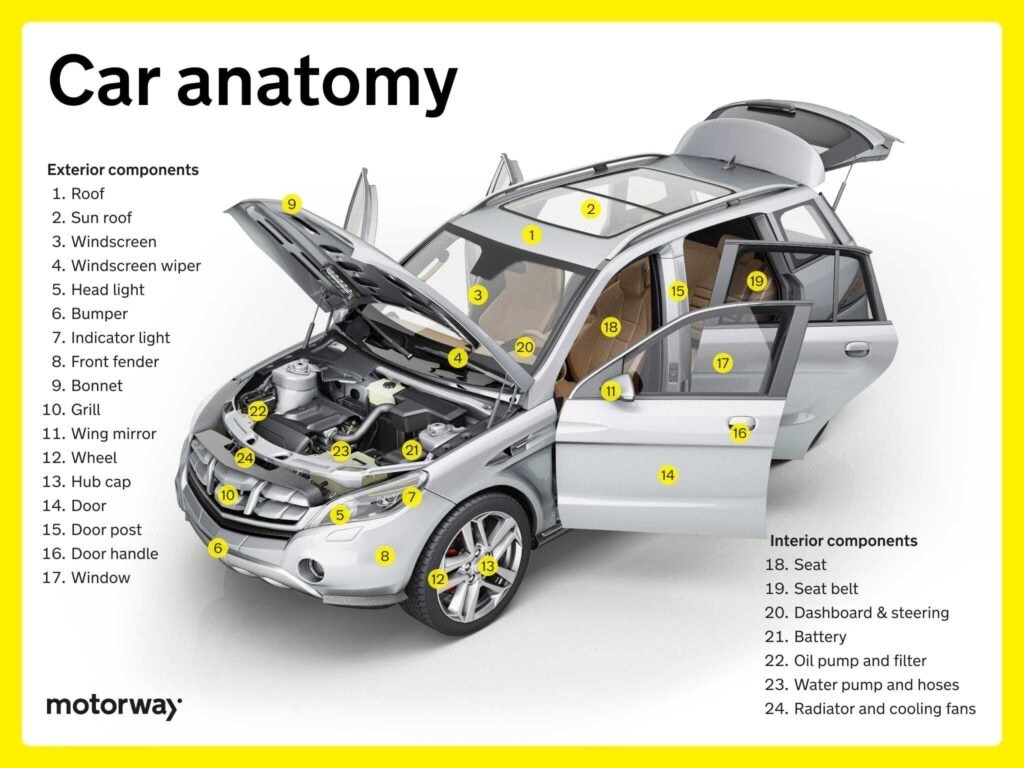
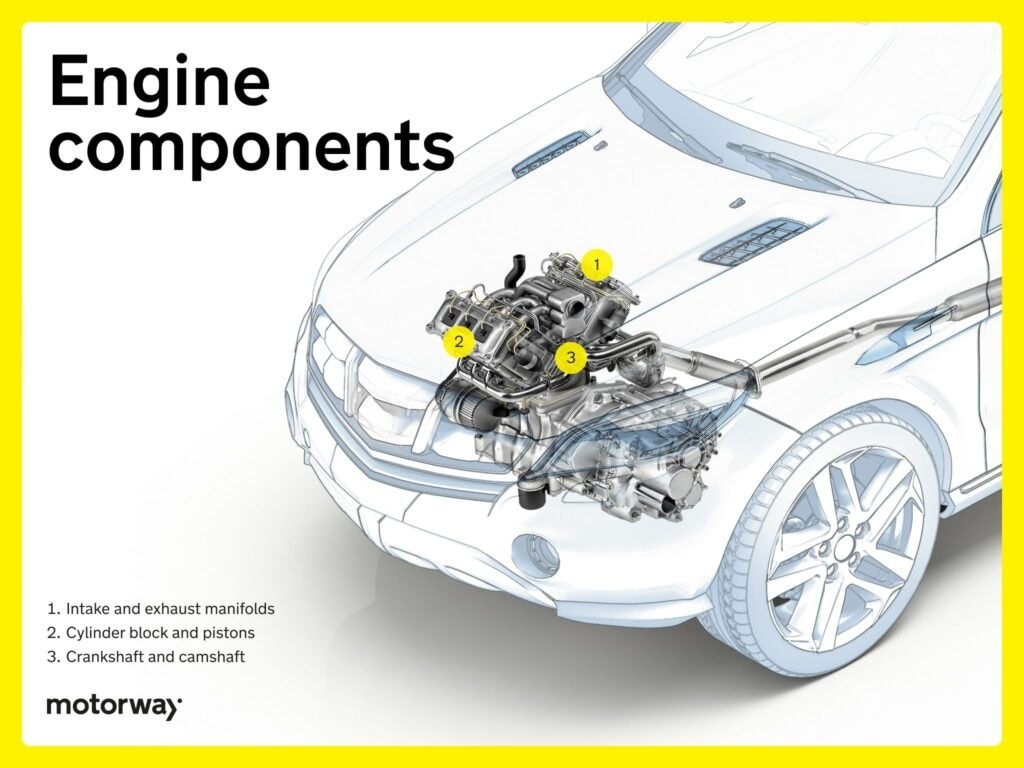
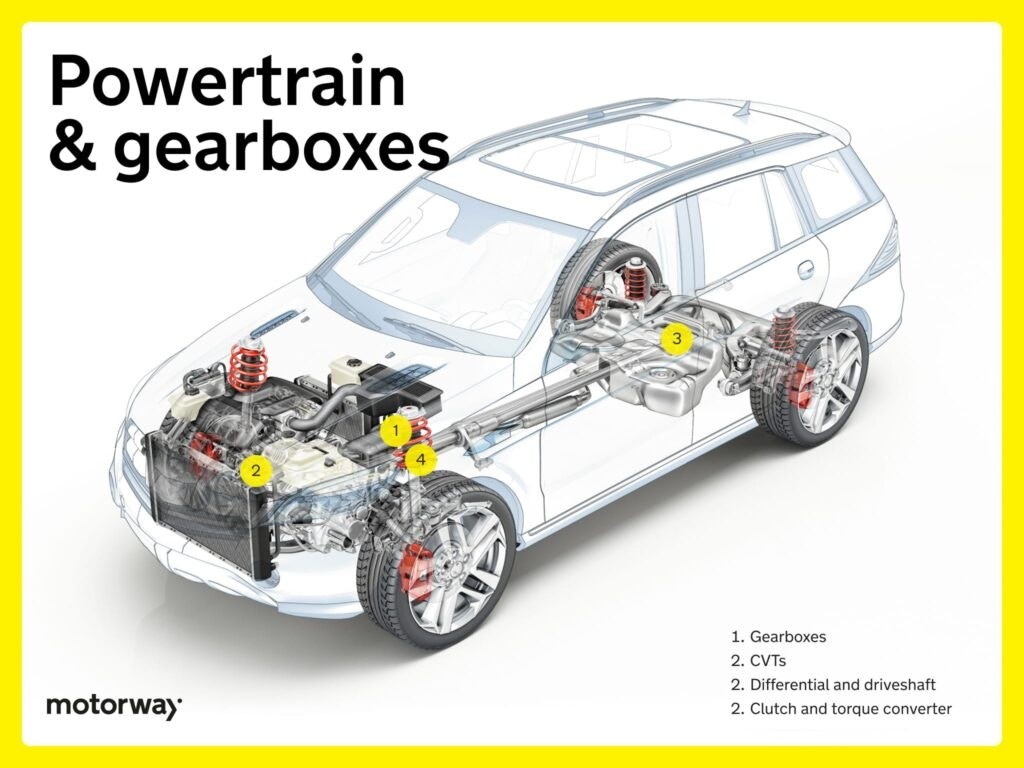
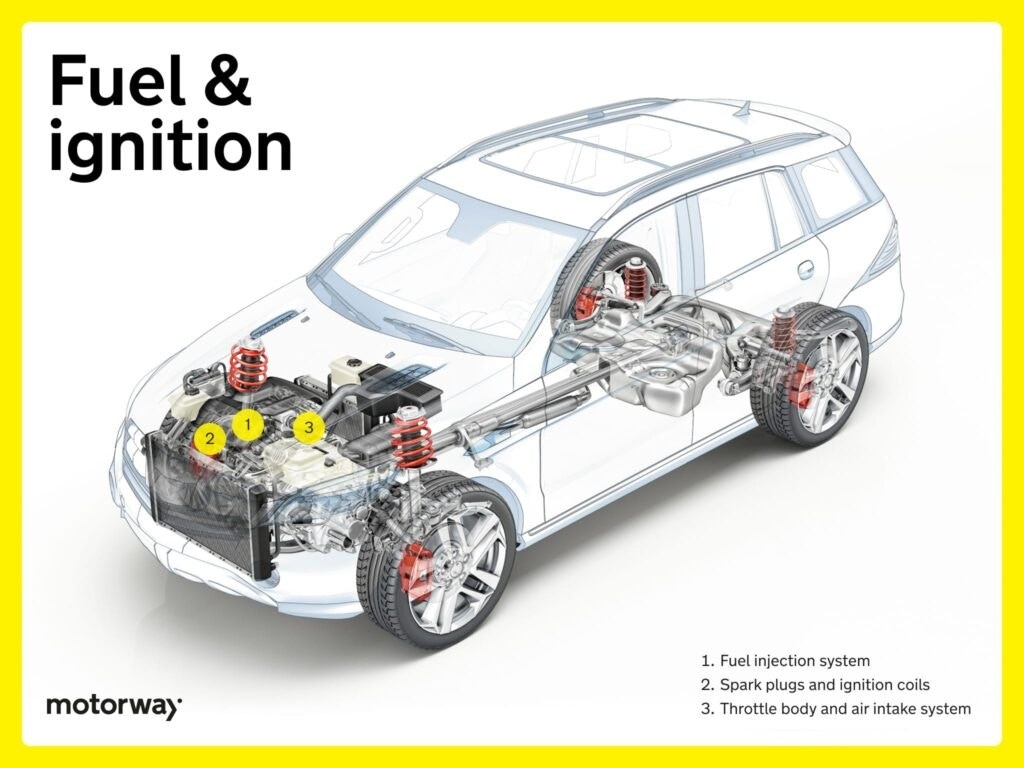
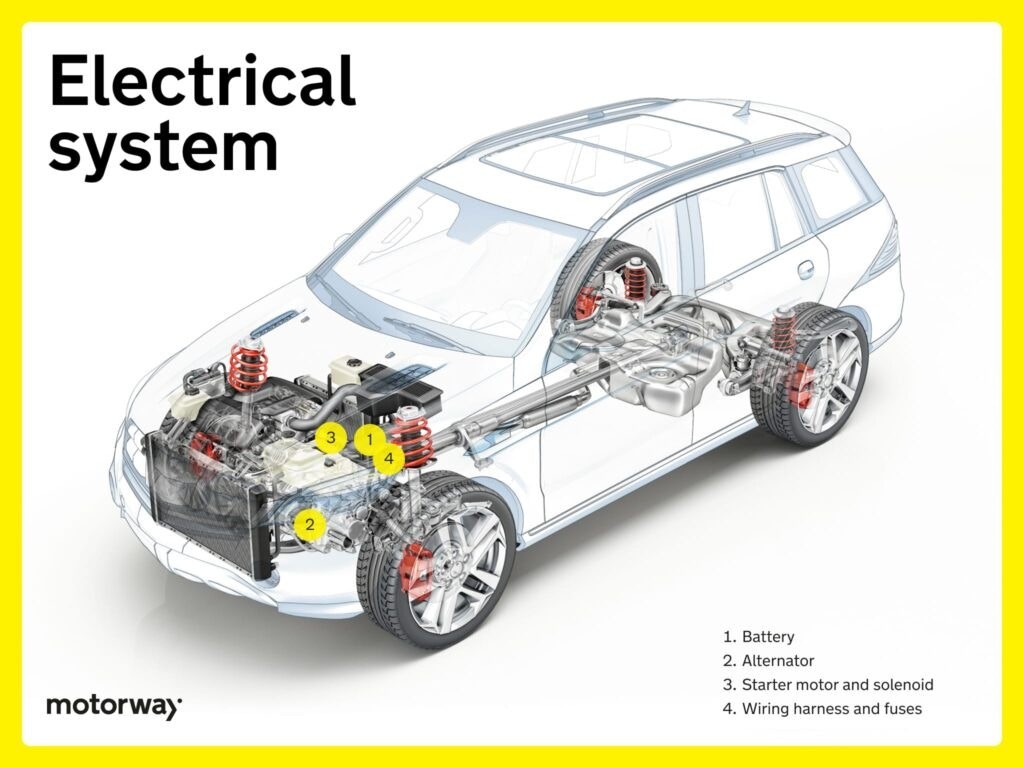
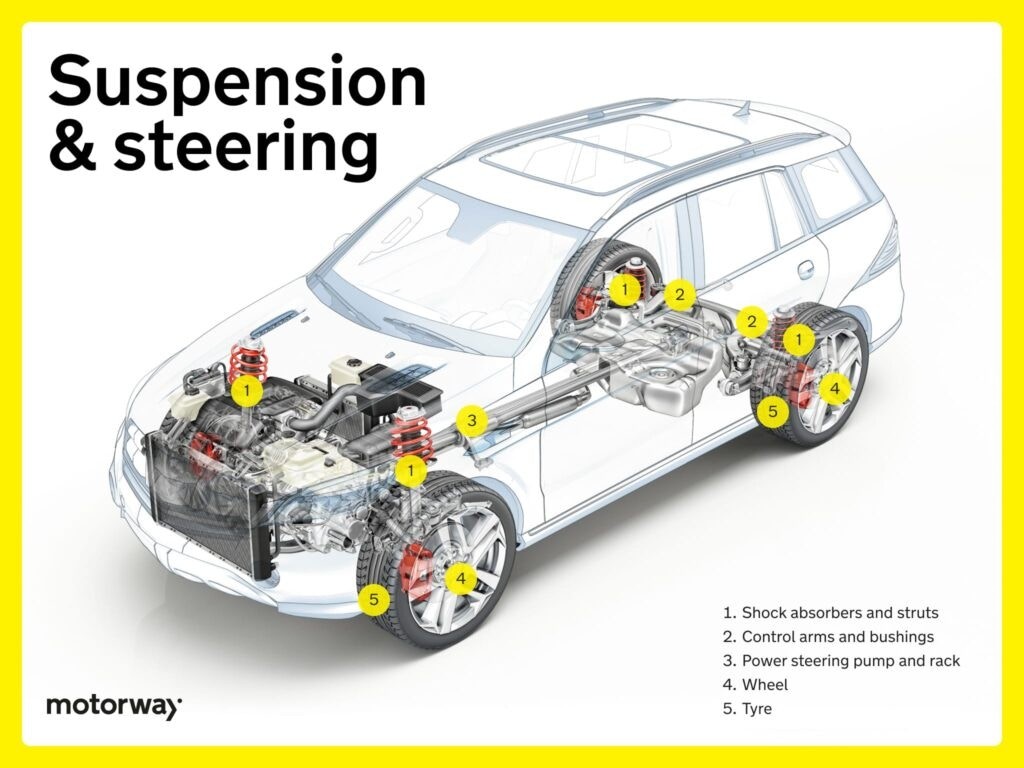
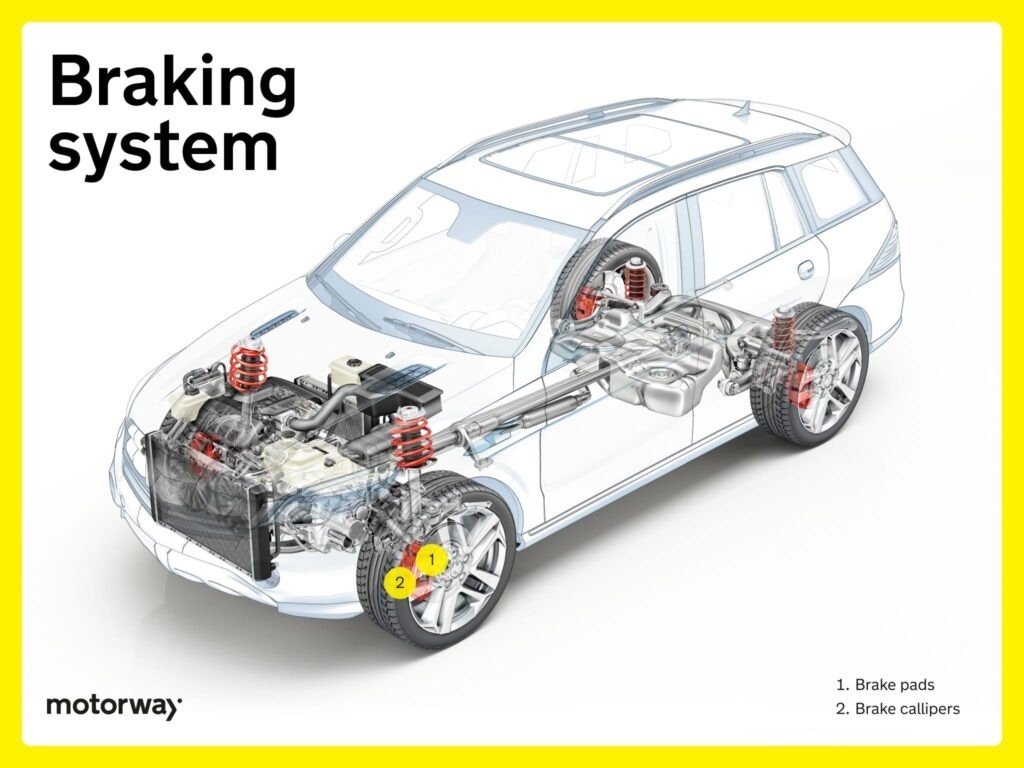
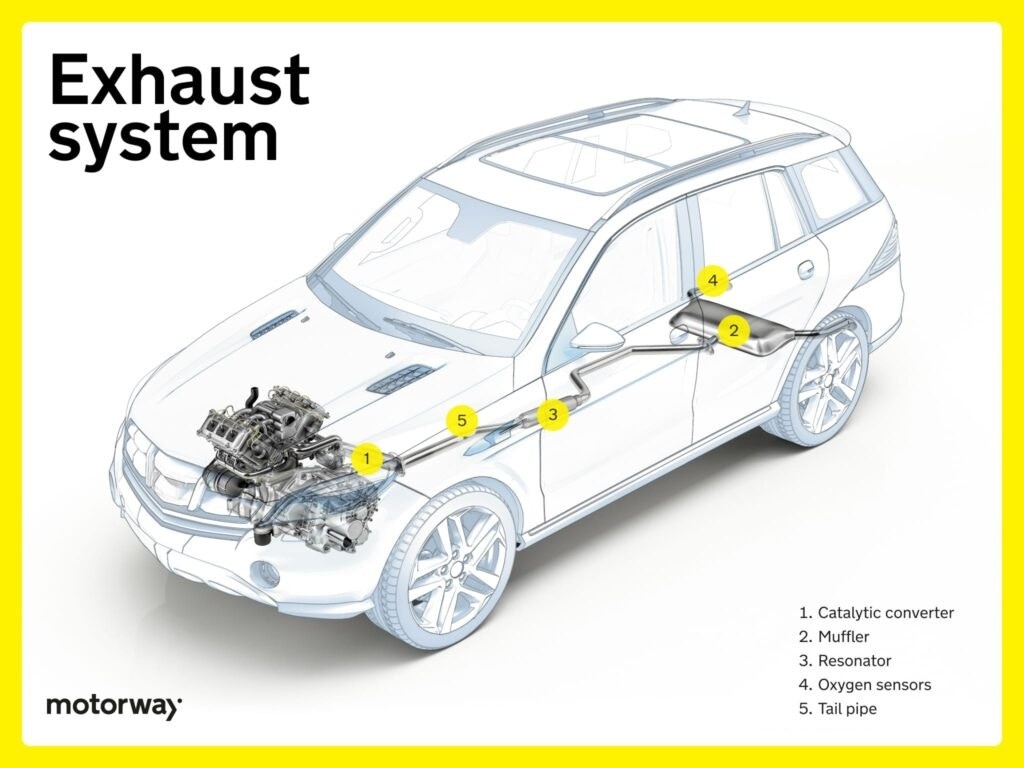
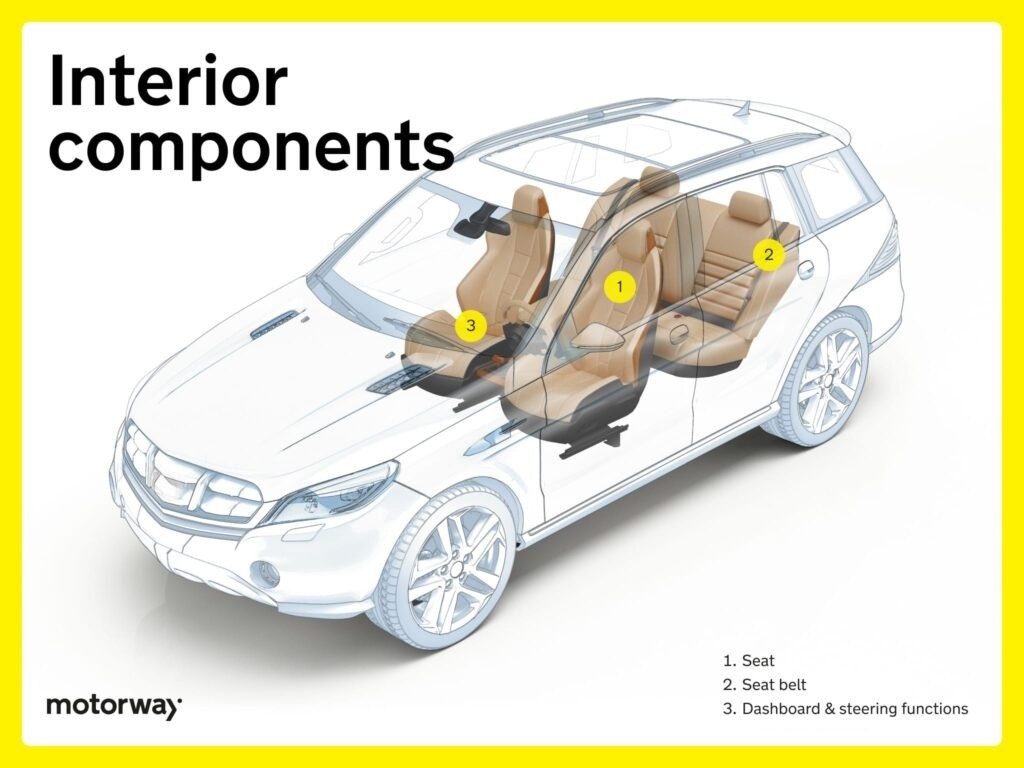
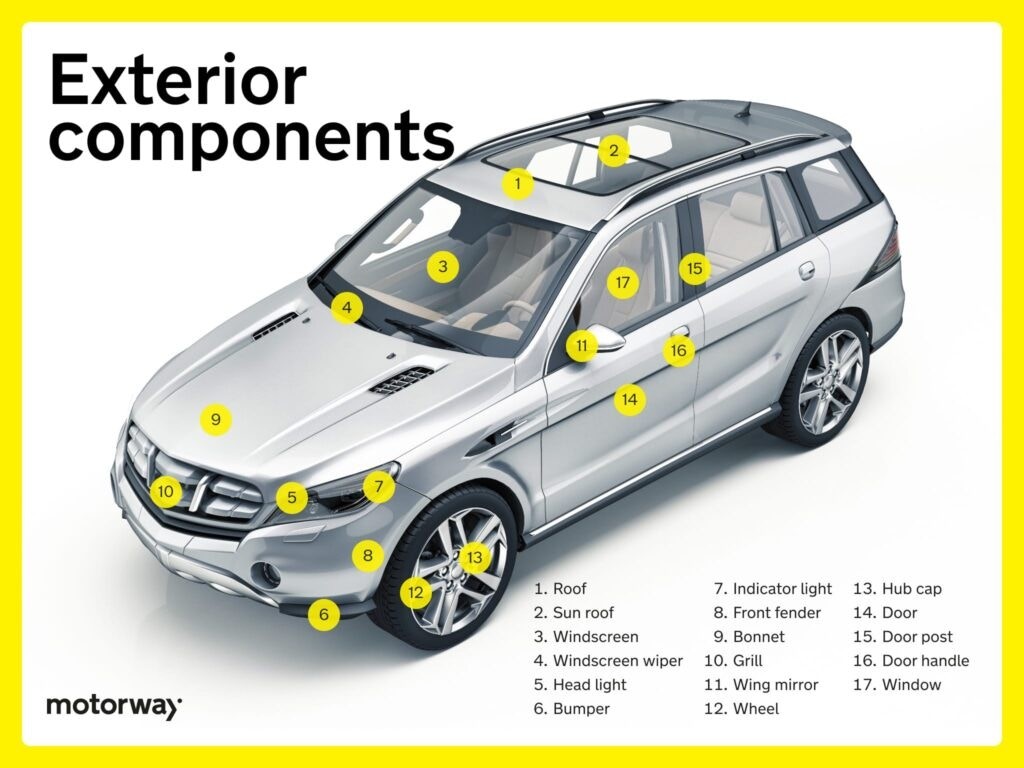
Wheel Construction Guide: Alloy vs. Steel Wheels
Wheel construction options include:
- One-piece construction: Made from a single material piece, common for alloy and steel wheels.
- Two-piece construction: Consisting of a center and outer rim, often bolted or welded, found in performance wheels.
- Three-piece construction: Modular design with a center, outer rim, and inner hoop, popular for customization.
- Forged construction: Compressed under high pressure, creating stronger and lighter wheels for high-performance applications.
- Multi-piece construction: Combining multiple components for versatile sizing and customization.
Material choices include:
- Alloy wheels: Lightweight mix of metals like aluminum or magnesium, improving heat dissipation and aesthetics.
- Steel wheels: Robust steel construction, durable and cost-effective for rugged conditions, though heavier than alloy wheels.
Tire Pressure Monitoring System (TPMS): Safety and Efficiency
TPMS is a safety feature that monitors tire pressure using sensors in each tire. It transmits real-time data to the car’s computer and warns the driver if pressure deviates from optimal levels, enhancing safety, fuel efficiency, and tire lifespan.
FAQs: Understanding Car Parts
What parts are under a car?
Labeled parts underneath car include essential systems like the engine, transmission, suspension, exhaust, and fuel system. These components work together to ensure your vehicle functions properly and performs well.
How many car parts are on a car?
Modern vehicles can contain over 30,000 individual parts across various systems, highlighting the complexity of car design. EVs typically have fewer parts due to simpler engines that rely on batteries instead of numerous mechanical components.
What are the important parts of a vehicle?
Crucial vehicle parts include the engine, transmission, brake system, steering system, suspension, and electrical components, each vital for vehicle safety and performance.
What parts of a car can be sold separately?
Engines, transmissions, body parts, and specific electrical parts can be sold individually, depending on demand and availability, offering options for repairs, replacements, or upgrades.
Why is there a shortage of car parts?
Car part shortages can result from supply chain disruptions, increased demand, manufacturing issues, and global events impacting production and distribution.
Need to Sell Your Car?
Want to discover more about car ownership, maintenance, and selling your car? Explore our guides here, covering topics from Clean Air Zones to car tax, and plate changes to part exchange.
